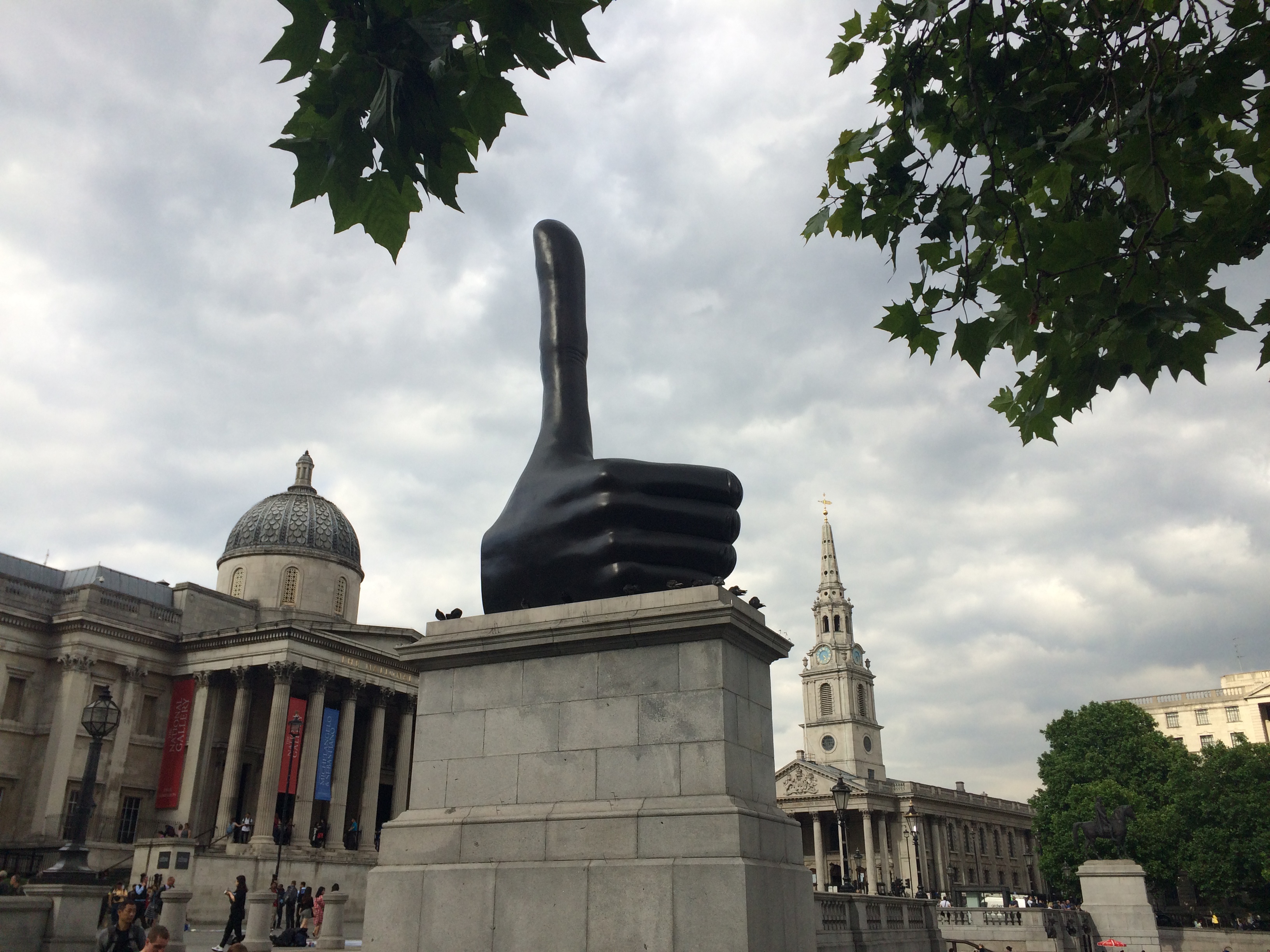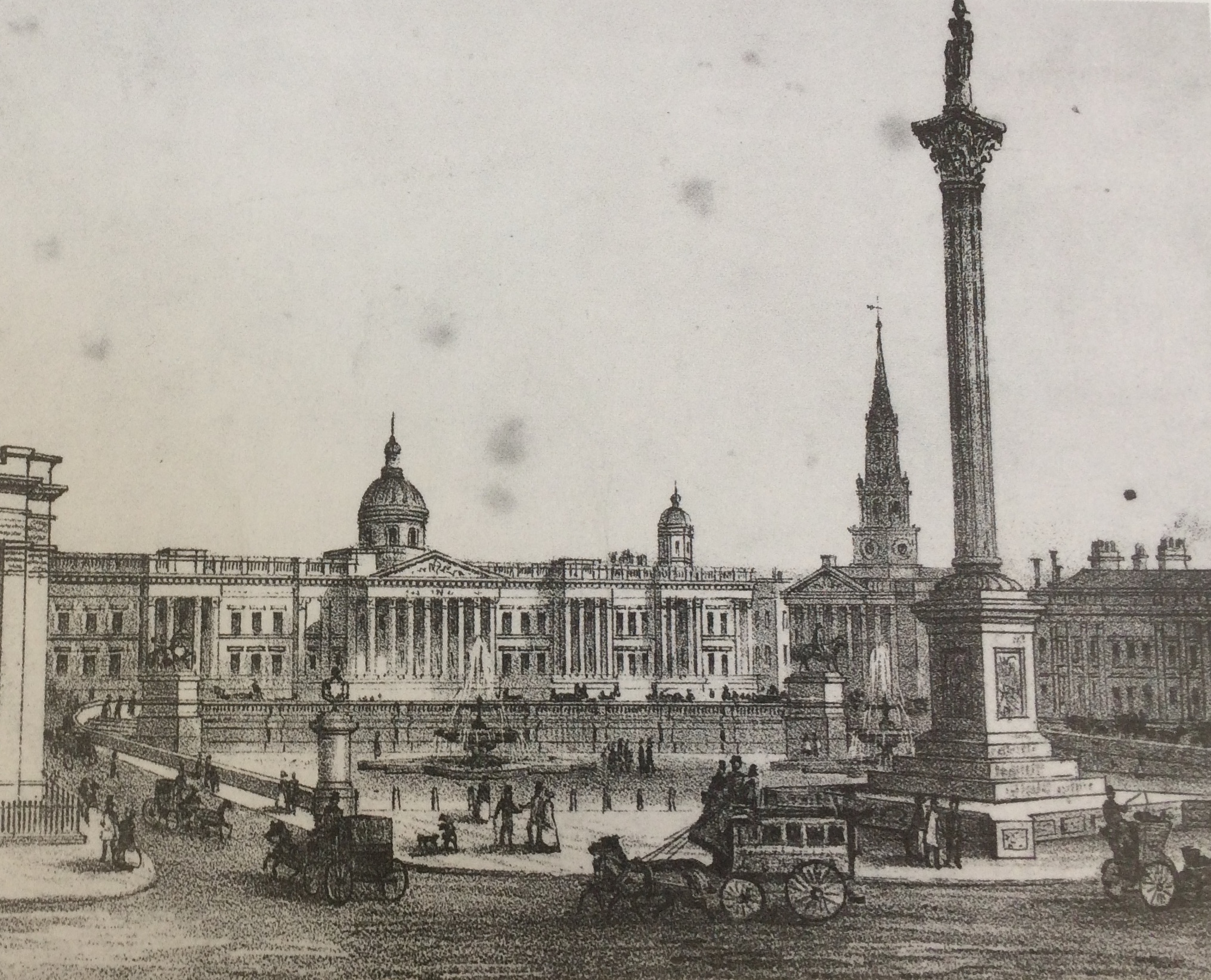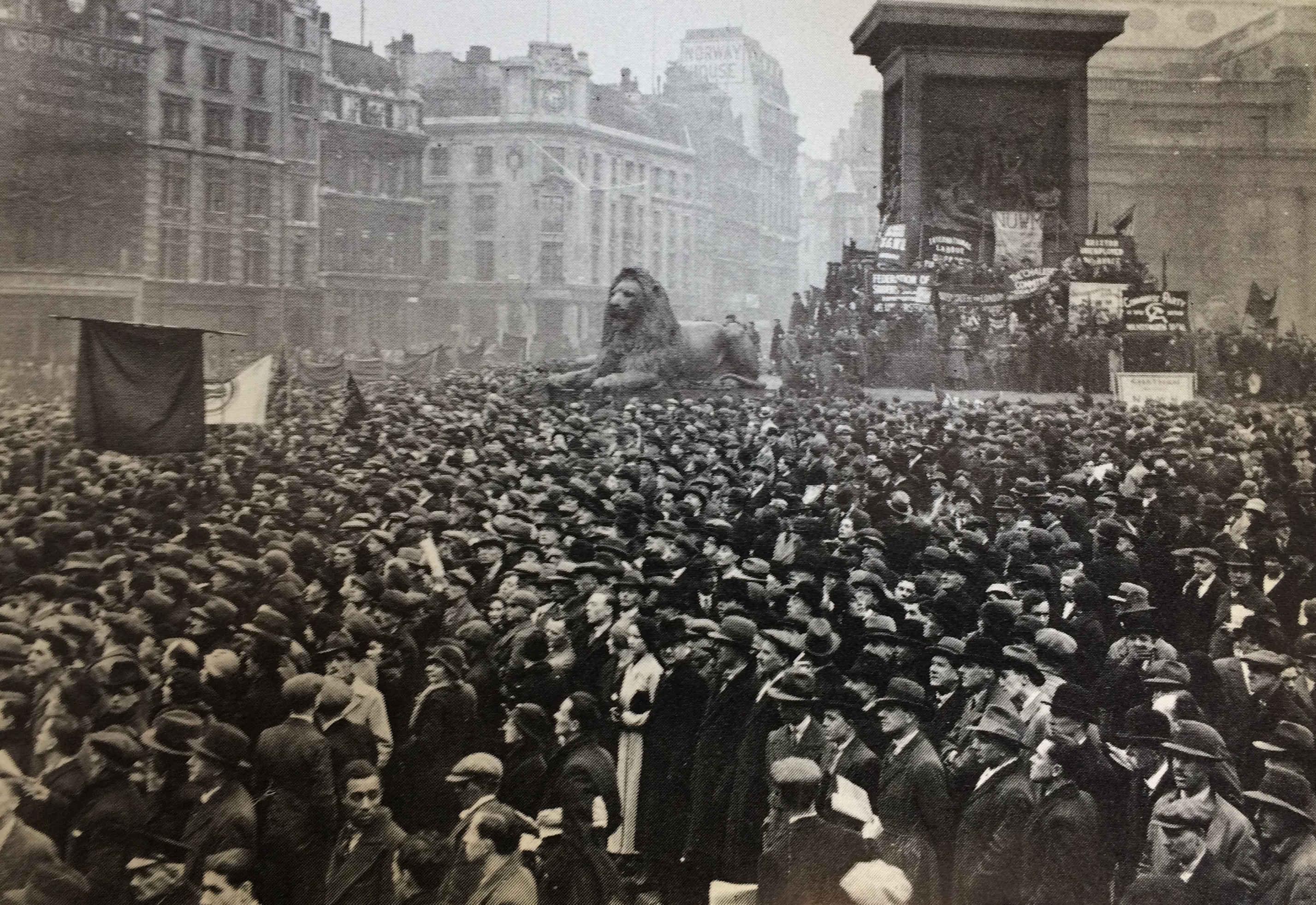Difference between revisions of "Significance of London's Fourth Plinth"
From Londonhua WIKI
(→Significance of London's Fourth Plinth) |
(→The Fourth Plinth) |
||
| Line 52: | Line 52: | ||
==The Fourth Plinth== | ==The Fourth Plinth== | ||
| − | |||
As time passed, pressure mounted for a depiction of some paragon in impossible to erect | As time passed, pressure mounted for a depiction of some paragon in impossible to erect | ||
pg. 125 on | pg. 125 on | ||
Revision as of 16:50, 20 June 2017
Significance of London's Fourth Plinth
by Cole Fawcett
 The Fourth Plinth, displaying its most recent commission, Really Good by David Shrigley |
Contents
Abstract
This Milestone takes a close analyzation of the public sculpture within the London scrutinizing it under the lens of historical significance and public use. In an effort to achieve this, the background consists of research done on how a variety of 7 or so sculptures came be commissioned on public land and use to the present. A inspired gallery depicting how these structures coexist and commingle with their environment will serve as the deliverable component of this milestone. Overall, this project attempts to shed light on the real effect public sculpture affects the city and people of London beyond a flashy tourist pull.
Introduction
I suggest you save this section for last. Describe the essence of this project. Cover what the project is and who cares in the first two sentences. Then cover what others have done like it, how your project is different. Discuss the extent to which your strategy for completing this project was new to you, or an extension of previous HUA experiences.
As you continue to think about your project milestones, reread the "Goals" narrative on defining project milestones from the HU2900 syllabus. Remember: the idea is to have equip your milestone with a really solid background and then some sort of "thing that you do". You'll need to add in some narrative to describe why you did the "thing that you did", which you'd probably want to do anyway. You can make it easy for your advisors to give you a high grade by ensuring that your project milestone work reflects careful, considerate, and comprehensive thought and effort in terms of your background review, and insightful, cumulative, and methodical approaches toward the creative components of your project milestone deliverables.
Section 1: Background
History of Trafalgar Square

an attempt at giving a palpable expression to the country's social and political aspirations. A place to look at and show off Places like trafalgar square, places that serve as their own countries signs of pride, all exist as the sole and absolute province of the ruling class, deciding what of and how history is remembered. Trafalgar square represents this in London as it has transformed from an 'esplanade peopled with figures of national heroes, into the country's foremost place politique.
21 October 1805, the last sea battle of Britain's war with France, The Battle of Trafalgar
Britain's victory established the country as the number one sea power. Sowing the seeds of the great british empire over the next 100 years
Horatio Nelson's death at Trafalgar, monument wanted to celebrate
35 years after Nelson's death, trafalgar square was decided as the spot for Nelson's honorary "national monument"
The actual construction of the square itself took place during 1842 and 1843, running into significantly less problems than Nelson's monument.[2] In 1844, a bronze statue commemorating the late George IV was installed on the squares eastern plinth. two plinths on the south side of the came in the late 19th century as a result of public subscriptions to the square, both depicting famous English war heroes. The south-west plinth was erected first in 1855-6 adorned by a bronze statue of General Sir Charles James Napier. The south-east plinth came five years later in 1861, topped with a bronze Major-General Sir Henry Havelock. [3]The so-called fourth plinth, located on Trafalgar Squares north-west corner, was originally built in 1841 to display a sculpture of William IV, but due to lack of funding remained empty all the way up until the very end of the 20th century in 1998.
Protest and Demonstration in Trafalgar Square

The land where Trafalgar square rests today has long been a politically charged forum for the "State" and "People" to voice their grievances and sometimes celebrate.
Entering the the 19th century, poor working conditions, urban and rural poverty, and middle class dissension took to the streets in increasingly organized fashion, finding trafalgar square a suitable place for "riotous assembly".
While much of rioting and outbreaks of public disorder became infrequent as the economy's upswing after 1850 saw a raised standard of living for the majority of the population, Trafalgar square continued to serve as a place of meeting and a platform for public demonstration into the 20th century.
Political unrest rose in London between 1887 and 1892 with the Troubles, a political, nationalistic conflicted over the northern irelands sovereignty. The incident that came to be known as Bloody Sunday saw protests at Trafalgar Squared turn hostile with violent police intervention. The square proved a ideal mass outdoor public meeting place to organize for Suffragettes throughout the early 20th century. In the twenty years following World War I, demonstrations in Trafalgar Square reflected the two dominant issues that faced the Labour movement: unemployment, and the fight against fascism. Demonstration in Trafalgar square frequently met high tension from London police enforcement. Campaigns for Nuclear disarmament, anti-war campaigns, and free speech protests pervaded the gatherings in Trafalgar square into the 21st century.
[5]
Anti-Apartheid, Gay rights 70s
poll tax riots 90s
anti-war '03
[6]
The Fourth Plinth
As time passed, pressure mounted for a depiction of some paragon in impossible to erect
pg. 125 on
[7]
Fourth plinth project initiated by Prue Leith on behalf of the Royal Society of Arts (RSA)
Sought to promote the site for a changing exhibition of contemporary, temporary artworks.
Initial line up of sculptures
Ecce Homo - Mark Wallinger
Regardless of History - Bill Woodrow
Monument - Rachel Whiteread
[8]
Section 2: Deliverable
In this section, provide your contribution, creative element, assessment, or observation with regard to your background research. This could be a new derivative work based on previous research, or some parallel to other events. In this section, describe the relationship between your background review and your deliverable; make the connection between the two clear.
Subsection 1
...use as many subsections or main sections as you need to support the claims for why what you did related to your Background section...
Subsection 2
...and so on and so forth...
Gallery
Conclusion
In this section, provide a summary or recap of your work, as well as potential areas of further inquiry (for yourself, future students, or other researchers).
References
Add a references section; consult the Help page for details about inserting citations in this page.
Attribution of Work
For milestones completed collaboratively, add a section here detailing the division of labor and work completed as part of this milestone. All collaborators may link to this single milestone article instead of creating duplicate pages. This section is not necessary for milestones completed by a single individual.
External Links
If appropriate, add an external links section
Image Gallery
If appropriate, add an image gallery
Category tags
Don't forget to add category tags!!! Your Milestone Pages MUST contain one "Project" Category tags like this:
[[Category:Art Projects]]
[[Category:Music Projects]]
[[Category:Philosophy & Religion Projects]]
[[Category:Drama & Theater Projects]]
[[Category:Writing & Rhetoric Projects]]
[[Category:History Projects]]
[[Category:English Projects]]
...and NO OTHER TAGS except for the year the project was completed by you, like this:
[[Category:2017]]
See the Category Help page for assistance. Don't include irrelevant category tags in your Milestone page (like the Template category!)
Delete this entire "Category section" when editing this page--Categories don't need a heading.
- ↑ Hood, J. (2005). Trafalgar Square: A Visual History of London's Landmark Through Time. London: B T Batsford.
- ↑ Mace, R. (1976). Trafalgar Square: emblem of empire. London: Lawrence & Wishart.
- ↑ Gater, G. H., & Hiorns, F. R. (Eds.). (1940). St Martin-in-The-Fields, Pt III: Trafalgar Square and Neighbourhood (Vol. 20, Survey of London). London: London County Council.
- ↑ Hargreaves, R. (2005). Trafalgar Square: through the camera. London: National Portrait Gallery Publications.
- ↑ Mace, R. (1976). Trafalgar Square: emblem of empire. London: Lawrence & Wishart.
- ↑ Hargreaves, R. (2005). Trafalgar Square: through the camera. London: National Portrait Gallery Publications.
- ↑ Hood, J. (2005). Trafalgar Square: A Visual History of London's Landmark Through Time. London: B T Batsford.
- ↑ Hargreaves, R. (2005). Trafalgar Square: through the camera. London: National Portrait Gallery Publications.



